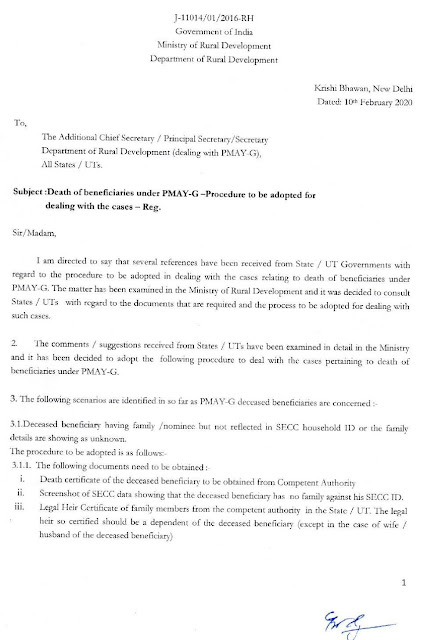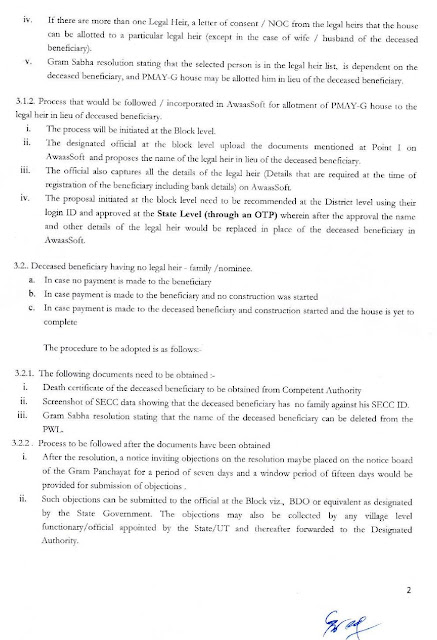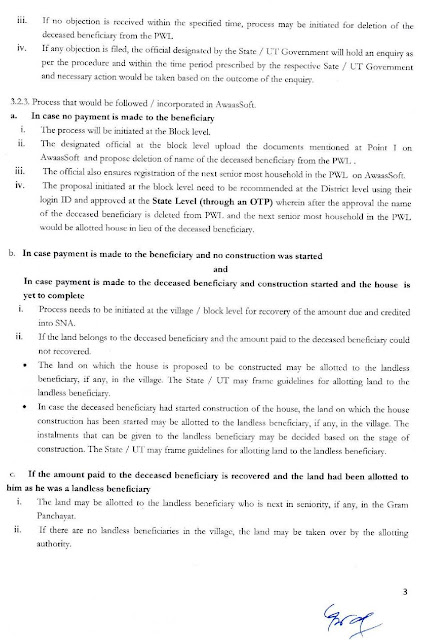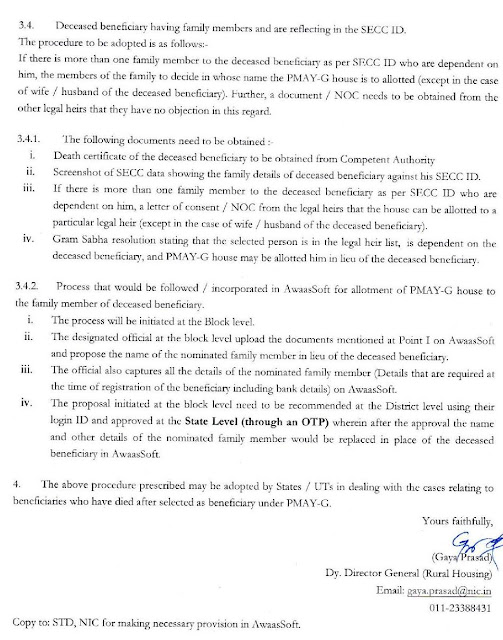PMAY-G के तहत लाभार्थियों की मृत्यु – मामलों से निपटने के लिए अपनाई जाने वाली प्रक्रिया
केंद्र सरकार द्वारा गरीब और बेघर लोगों के रहने के लिए घर देने के लिए चलाई जा रही योजना “प्रधानमंत्री आवास योजना-ग्रामीण” में एक और सुविधा देते हुए सरकार ने एक सर्कुलर जारी किया है, कि यदि लाभार्थी की मृत्यु हो जाए तो क्या प्रक्रिया अपनाई जानी चाहिए.
J-11014/01/2016-RH
Government of India
Ministry of Rural Development
Department of Rural Development
Krishi Bhawan, New Delhi
Dated: 10th February 2020
To,
The Additional Chief Secretary / Principal Secretary / Secretary
Department of Rural Development (dealing with PMAY-G),
All States / UTs.
Subject: Death of beneficiaries under PMAY-G – Procedure to be adopted for dealing with the cases – Reg. ( PMAY-G के तहत लाभार्थियों की मृत्यु – मामलों से निपटने के लिए अपनाई जाने वाली प्रक्रिया )
Sir/Madam,
I am directed to say that several references have been received from State / UT Governments with regard to the procedure to be adopted in dealing with the case relating to death of beneficiaries under PMAY-G. The matter has been examined in the Ministry of Rural Development and it was decided to consult States / UTs with regard to the documents that are required and the process to be adopted for dealing with such cases.
2. The comments / suggestions received from States / UTs have been examined in detail in the Ministry and it has been decided to adopt the following procedure to deal with the case pertaining to death of beneficiaries under PMAY-G.
3. The following scenarios are identified in so far as PMAY-G deceased beneficiaries are concerned:-
3.1. Deceased beneficiary having family / nominee but not reflected in SECC household ID or the family details are showing as unknown.
The procedure to be adopted is as follow:-
3.1.1. The following documents need to be obtained:-
- Death certificate of the deceased beneficiary to be obtained from Component Authority.
- Screenshot of SECC data showing that the deceased beneficiary has no family against his SECC ID.
- Legal Heir Certificate of family members from the competent authority in the State/UT. The legal heir so certified should be a dependent of the deceased beneficiary (except in the case of wife/husband of the deceased beneficiary)
- If there are more than one Legal Heir, a letter of consent / NOC from the legal heirs that the house can be allotted to a particular legal heir (except in the case of wife/husband of the deceased beneficiary).
- Gram Sabha resolution stating that the selected person is in the legal heir list, is dependent on the deceased beneficiary, and PMAY-G house may be allotted him in lieu of the deceased beneficiary.
3.1.2. Process that would be followed / incorporated in Awaas Soft for allotment of PMAY-G house to the legal heir in lieu of deceased beneficiary.
- The process will be initiated at the Block level.
- The designated official at the block level upload the documents mentioned at Point I on AwaasSoft and proposes the names of the legal heir in lieu of the deceased beneficiary.
- The official also captures all the details of the legal heir (Details that are required at the time of registration of the beneficiary including bank details) on AwaasSoft.
- The proposal initiated at the block level need to be recommended at the District level using their login ID and approved at the State Level (through an OTP) wherein after the approval the name and other details of the legal heir would be replaced in place of the deceased beneficiary in AwaasSoft.
3.2. Deceased beneficiary having no legal heir – family/nominee-
a. In case no payment is made to the beneficiary.
b. In case payment is made to the beneficiary and no construction was started
c. In case payment is made to the deceased beneficiary and construction started and the house is yet to complete
The procedure to be adopted is as follows:-
3.2.1. The following documents need to be obtained:-
- Death certificate of the deceased beneficiary to be obtained from Competent Authority
- Screenshot of SECC data showing that the deceased beneficiary has no family against his SECC ID.
- Gram Sabha resolution starting that the name of the deceased beneficiary can be deleted from the PWL.
3.2.2. Process to be followed after the documents have been obtained
- After the resolution, a notice inviting objections on the resolution maybe placed on the notice board of the Gram Panchayat for a period of seven days and a window period of fifteen days would be provided for submission of objections.
- Such objections can be submitted to the official at the Block viz., BDO or equivalent as designated by the State Government. The objections may also be collected by any village level functionary/official appointed by the State/UT and thereafter forwarded to the Designated Authority.
- If no objection is received within the specified time, process may be initiated for deletion of the deceased beneficiary from the PWL.
- If any objection is filed, the official designated by the State/UT Government will hold an enquiry as per the procedure and within the time period prescribed by the respective State/UT Government and necessary action would be taken based on the outcome of the enquiry.
3.2.3. Process that would be followed/incorporated in AwaasSoft.
a. In case no payment is made to the beneficiary
- The process will be initiated at the Block level.
- The designated official at the block level upload the documents mentioned at Point I on AwaasSoft and propose deletion of name of the deceased beneficiary from the PWL.
- The official also ensures registration of the next senior most household in the PWL on AwaasSoft.
- The proposal initiated at the block level need to be recommended at the District level using their login ID and approved at the State level (through an OTP) wherein after the approval the name of the deceased beneficiary is deleted from PWL and the next senior most household in the PWL would be allotted house in lieu of the deceased beneficiary.
b. In case payment is made to the beneficiary and no construction was started
and
In case payment is made to the deceased beneficiary and construction started and the house is yet to complete
- Process needs to be initiated at the village/block level for recovery of the amount due and credited into SNA.
- If the land belongs to the deceased beneficiary and the amount paid to the deceased beneficiary could not recovered.
- The land on which the house is proposed to be constructed may be allotted to the landless beneficiary, if you, in the village. The State/UT may frame guidelines for allotting land to the landless beneficiary.
- In case the deceased beneficiary had started construction of the house, the land on which the house construction has been started may be allotted to the landless beneficiary, if you, in the village. The installments that can be given to the landless beneficiary may be decided based on the stage of construction. The State/UT may frame guidelines for allotting land to the landless beneficiary.
c. If the amount paid to the deceased beneficiary is recovered and the land had been allotted to him as he was a landless beneficiary
- The land may be allotted to the landless beneficiary who is next in seniority, if you, in the Gram Panchayat.
- If there are no landless beneficiaries in the village, the land may be taken over by the allotting authority.
- The process of deleting the name of the deceased beneficiary from the PWL as enumerated at para III (a) above would be followed in respect of scenarios (b) to (c).
3.3. Deceased beneficiary having minor family member and is reflecting in the SECC ID.
and
Deceased beneficiary having minor family member and is not reflecting in the SECC ID.
The procedure to be adopted for para 3.3 above are as follow:-
3.3.1. The following documents need to be obtained:-
- Death certificate of the deceased beneficiary to be obtained from Competent Authority
- Date of birth certificate of the minor
- Screenshot of SECC data showing that the deceased beneficiary has only minor family member against his SECC ID.
- A guardian to the minor need to be identified and a certificate from the Competent Authority as decided by State/UT Government to be obtained that the person identified is the guardian of the minor / minors. If no guardian is available, the Block / village official may act as a guardian for receiving assistance and completion of the house.
- A certificate from the guardian that the house should be allotted in the name of a particular minor
- A certificate from the Gram Panchayat that the minor is the family member of the deceased beneficiary and is dependent on the deceased beneficiary. The certificate should also mention that the minor is in the care of the identified guardian and the assistance under PMAY-G can be transferred to the guardian of that particular minor identified.
- If the minor family member and is not reflecting in the SECC ID of Deceased beneficiary, Minor family member of the deceased beneficiary has to obtain Legal Heir Certificate from the competent authority in the State/UT. The legal heir so certifies should be a dependent of the deceased beneficiary.
3.3.2. Process that would be followed / incorporated in AwaasSoft for allotment of PMAY-G house to the minor family member of deceased beneficiary.
- The process will be initiated at the Block level.
- The designated official at the block level upload the documents mentioned at Point I on AwaasSoft and proposes the name of the minor alongwith the Guardian in lieu of the deceased beneficiary.
- The official also captures all the details of the minor / Guardian (Details that are required at the time of registration of the beneficiary including bank details) on AwaasSoft.
- The proposal initiated at the block level need to be recommended at the District level using their login ID and approved at the State Level (through an OTP) wherein after the approval the name and other details of the legal heir would be replaced in place of the deceased beneficiary in AwaasSoft.
3.4. Deceased beneficiary having family members and are reflecting in the SECC ID.
The procedure to be adopted is as follow:-
If there is more than one family member to the deceased beneficiary as per SECC ID who are dependent on him, the members of the family to decide in whose name the PMAY-G house is to allotted (except in the case of wife/husband of the deceased beneficiary). Further, a document / NOC needs to be obtained from the other legal heirs that they have no objection in this regard.
3.4.1. The following documents need to be obtained:-
- Death certificate of the deceased beneficiary to be obtained from Competent Authority
- Screenshot of SECC data showing the family details of deceased beneficiary as per SECC ID.
- If there is more than one family member to the deceased beneficiary as per SECC ID who are dependent on him, a letter of consent / NOC from the legal heirs that the house can be allotted to a particular legal heir (except in the case of wife/husband of the deceased beneficiary).
- Gram Sabha resolution stating that the selected person is in the legal heir list, is dependent on the deceased beneficiary, and PMAY-G house may be allotted him in lieu of the deceased beneficiary.
3.4.2. Process that would be followed / incorporated in AwaasSoft for allotment of PMAY-G house to the family member of deceased beneficiary.
- The process will be initiated at the Block level.
- The designated official at the block level upload the documents mentioned at Point I on AwaasSoft and propose the name of the nominated family member in lieu of the deceased beneficiary.
- The official also captures all the details of the nominated family member (Details that are required at the time of registration of the beneficiary including bank details) on AwaasSoft.
- The proposal initiated at the State Level (through an OTP) wherein after the approval the name and other details of the nominated family member would be replaced in place of the deceased beneficiary in AwaasSoft.
4. The above procedure prescribed may be adopted by States/UTs in dealing with the cases relating to beneficiaries who have died after selected as beneficiary under PMAY-G.
Yours faithfully,
(Gaya Prasad)
Dy. Director General (Rural Housing)
Source: PMAY-G





